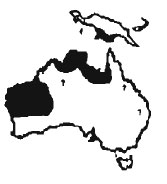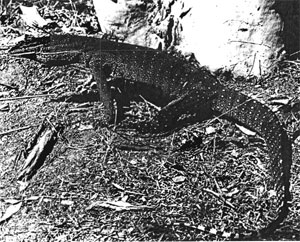Varanus Gouldii
(See notes on taxonomy under V. flavirufus)Gould's goanna
Varanus panoptes panoptes - Varanus gouldii gouldii Grey 1838
Varanus panoptes rubidus =Varanus gouldii rubidus Storr 1980.
Varanus panoptes horni = Varanus gouldii horni Bohme 1988
 |
At present three subspecies are recognised; V.gouldii gouldii inhabits the extreme north of eastern Western Australia and the Northern Territory, the islands of the Torres Straits and probably many other islands off the northern coast and V.gouldii horni is found in southern New Guinea. Records of Varanus gouldii on the islands of the Torres Straits and many other islands off the northern coast probably represent V.gouldii, but it is unclear whether they show more resemblance to Vg.gouldii or V.g.horni. An isolated race. V.gouldii rubidus, exists in central Western Australia. Animals from the north of Australia and New Guinea have a banded tail tip and more midbody scale rows than V.flavirufus (192242 vs. 132-189). The animals from New Guinea have 170-205 midbody scale rows, but otherwise there do not appear to be any distinguishing morphological characters. Vg .rubidus has a plain tail tip and mainland forms have 195-223 midbody scale rows. Island populations (i.e. from Dolphin Island) have as few as 176 scales rows. In pattern V.gouldii differs from V flavirufus by possessing well defined pale and dark spots, usually arranged in rows over the back (Storr 1980; Bohme 1988).
The range of this species may be much greater than is suggested by the current literature. Schmida (1985) notes that specimens of "V.gouldii" in the Sydney sannstone region are darkly coloured with ten rows of yellow spots on the back and have a banded tail tip. At present the diagnostic characteristics used to distinguish between V.gouldii and V .flavirufus no not appear to be 100% reliable. Comparisons of animals from throughout Australia, both from a morphological ann biochemical perspective, are needed before the taxonomy of this group can be revised satisfactorily. Some anditional information on this group of monitors call be found in Grunnke & Grundke (1992b).
Gould's goanna is a mighty lizard. They are heavily built, powerful and fearless creatures that often anopt a bipedal stance, either in response to a threat or to gain a better vantage point (e.g. Barbour 1943). They have very powerful front limbs and frequent areas of tightly-packed sand and clay.
Virtually nothing is known of the way of life of the New Guinea subspecies gouldii horni. Bohme (1988) suggest a maximum size of at least 140cm TL., and records the following locations; Teluk Berau, Gelib, Maerauke, Koerik, Bensbach, Port Moresby, Aroma and Yule Island and suggests that they may be found throughout the grasslands of southern New Guinea. Whitaker et al (1982) record it only from Western ann Central Province in Papua New Gui nea. Parker (1970) claims that this lizard was once common around Port Moresby but latterly survived only on a few nearby islands (including Loloata and Motupuri).
 |
Little is known of the ecology of V.gouldii robidus. Bodies of water are absent from most of its range. Like the nominate race they appear to favour harder substrates than Gould's goanna. At Wanjarri, an abandoned cattle station in Western Australia, they dig deep (130cm) burrows in ground packed rock-hard by thousands of hooves. When I visited in 1990 a drought had caused a mass die-off of kangaroos and the ground was littered with corpses in various states of decay and large numbers of kangaroos on the verge of death. Bloateel Gould's goannas were feasting on the flesh of a particularly foul, putrid smelling and maggot-ridden corpse, tearing off chunks of rotten flesh with the forelimbs and devouring them with apparent delight The largest V.g. rubidus recorded by Storr (1980) measured 50 SVL (137cm TL). The largest specimen at Wanjarri measured 64cm SVL (155cm TL) and weighed over 5000g. Its swollen belly must have contained at least a kilo of festering meal. In comparison another specimen of 56cm SVL (135cm TL) weighed only 1750g. It was extremely thin and may have been attracted to the area from afar by the smell of decay. Bipedal ritual combat is said to occur between adults congregated around carrion (Bennett 1992). In this area Gould's goannas are absent from areas of softer sand.
The only report of captive breeding in this species is by Haninger Berlin (1994). A pair were allowed to remain inactive in the dark at 16-18°C for three months of the year, separated for a month and then reunited, whereupon courtship,and mating occured within a month. A single clutch of up to 11 eggs is produced which hatch after 210-229 days at 28°C. At cooler temperatures they can take up to 356 days to develop. Hatchlings measure about 30cm TL and weigh around 27g. These animals require spacious enclosures with plenty of hiding places.
Attribution / Courtesy: Daniel Bennett. 1995. A Little Book of Monitor Lizards. Viper Press U.K.




